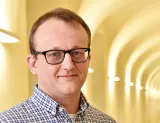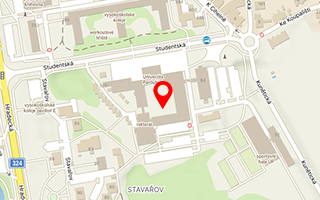Published: 28.07.2021
Seven and half a million volumes. The oldest and the most valuable books in our country. Precious incunabula and parchment manuscripts. This is our cultural heritage stored in the collection of the National Library of the Czech Republic. As of this may, the complete operation of this important institution will fall under the management of its new general director, Tomáš Foltýn, who is a graduate of the Faculty of Arts and Philosophy. He will thus become the tenth post-revolution director. His vision of the Library is crystallising, including the one about the design of a new building. “It should become a showcase of the Czech librarianship,” he says.
When did you first visit the National Library?
Unfortunately, I can’t remember. Anyway, as a student, I had a reader’s card, which I still may find somewhere at home. Since I studied at the Faculty of Arts and Philosophy in Pardubice, I used to visit other libraries – the local University Library and the Regional Library or the Research Library in Hradec Králové.
Have you had a clear idea of which direction you wanted to take since the beginning of your studies?
When you enter a university after secondary school, you don’t think about what will happen in five years. I joined the Department of Historical Sciences with the idea to focus on this area from the broadest point of view, whether it is research work oriented towards our history or employment in memory institutions.
What did you study?
In my bachelor’s studies, I devoted myself to cultural history specialised in museology, whereas in the master’s programme, I focused on regional history.
However, you graduated from the Business Academy in Beroun before that.
I did. It was a school that prepared well for future studies at universities with an economic or legal focus. I also applied for a similar type of school. I didn’t get to my dream studies as I always missed a little bit. Although I passed the entrance examinations successfully, the competition was quite stiff as my generation was that of the baby boomers.
Before university, I studied languages, namely English and German. Foreign languages are essential for any branch of study. But I also enjoyed reading, was interested in history, liked to go sightseeing. That’s why I applied to Pardubice the following year, which I’ve never regretted. Studying at the University of Pardubice was very inspiring for me, and it gave me a lot for life.
When you began to study at the University of Pardubice, you were a member of an interesting and perspective team of today’s Dean, Jiří Kubeš. What was your focus?
It was aristocratic families, especially in the post-White Mountain period, the education of aristocrats and the phenomenon of Grand Tours, but also some other aspects of noble life. Thanks to a healthy atmosphere and support from Jiří Kubeš, many professional studies were created and published by the students themselves. There was also positive pressure from management towards the students to keep presenting their results. I think that it’s good for the future of university students to get used to acting in the scientific community, use language and argue for their research, whether in the form of annotations or by attending scientific conferences.
Just like you got used to when you published professional articles and collected points in historical competitions…
Successful representation of the Institute of History at the Faculty of Arts and Philosophy reaches far back to the past. And I was neither the first nor the last. In 2005, I finished second in the national student competition called History, where I introduced the results of my Bachelor thesis about Grand Tours, especially from the point of travel institutions. Thanks to the support of foreign student educational stays, I was able to do research in Viennese archives and devote myself to the study of the Baroque nobility, which culminated with my diploma thesis.
Did you stay in touch with your classmates after the studies?
Yes. We still come together with some. It’s another added value of university study.
And what about memories of your teachers? Stories about some of them are often around a long time after graduation…
I can remember Prof. Jiří Škabrada, who focused on historic buildings. We had unforgettable lectures with him on how the buildings developed. We went on a study trip around east Bohemia. We visited old buildings and cottages and admired how well they had been handcrafted. It was an incredible experience.
I love to recollect the lectures on the Middle Ages with Associate Professor Teplý, who managed to involve us in the issue with his enthusiasm. At the times of my studies, the team of teachers at the Institute of History was perfect. They encouraged students, worked intensively with them, and there was an overall good atmosphere. The years spent there were very nice in terms of study and personal ties.
Has cooperation between the Institute of History and the National Library been outlined yet?
There have been several interconnections between the Institute of History and the National Library so far. On optional lectures, our colleagues and we introduced students of the University of Pardubice to digitisation. Some experts in librarianship participated in professional conferences organised by the Institute.
Concerning my new position, I’d like to continue this cooperation in a broader spectrum of universities. There is, for example, Digital Humanities, which is a very progressive trend in the research of historical data. Thanks to computer technology, it’s possible to analyse a large number of texts and look for contexts in them, which would otherwise be very difficult to do by ordinary reading. Memory institutions have a lot to offer in terms of their content but also when it comes to the experience of their research and expert employees who process the data. Their knowledge can be effectively linked with bachelor’s and master’s degree education.
Will you draft any of the students to the Library?
There’re several graduates of the Faculty of Arts and Philosophy already working for us in the Library.
Your work calendar is bustling now. You must hand over the director’s agenda of the Division of Fund Management and prepare for your new role as the general director of the National Library. What is going to change?
We’ll see when I become the director. My current agenda is not small. It includes many responsibilities towards conceptual and methodological issues. I cooperate with other libraries, and our Division solves practical procedures of various library activities, research projects, and other activities. I’ll move from a narrower focus, connected to digitisation, fund protection, and fund management, to global issues as I’ll also be in charge of new agendas related to, for example, education and economy. I may not deal with partial agendas, but being the director will give me a broader overview of what’s going on.
Leaving the Division of Fund Management will not be in the name of “burning my boats behind me”; that I’ll finish at the end of April and won’t deal with anything anymore. I’ll stay at hand to my successor, Anna Vandasová, for some time. I’m sure it’ll similarly work on the part of the current director of the National Library, Vít Richter. We have a schedule of when and how to hand the individual agendas over.
Do you know how many directors of the National Library of the Czech Republic were there before you?
Not exactly. I guess it’ll be around ten – if I also count the post-revolutionary directors. The Library got its name in 1995.
You will be the fortieth director of the Library since 1777. What are your plans?
I wish the National Library offered services and activities that the user community expects from us. At present, these services are mainly connected with the digital world. None of us knows how the pandemic will evolve. Digital services have proved to be essential for the operation of institutions of our type. Here, we would like to continue in what the Library already offers. Digitisation projects, like Manuscriptorium, Kramerius, or Webarchiv, have a nationwide reach and European prestige.
I would also like that all the backbone services provided by the National Library be further developed. For example, there’s a top-rated service called Ask your Library, where users can ask experts on various topics. You can see questions on various professional issues and some “lighter questions”; for example, where the Little Mole (i.e. a famous animated character) has his loo.
I’d also like to encourage activities aimed at supporting research. The National Library of the Czech Republic has unique collections, and it often serves as a library of last resort, where readers come to look for a document unavailable elsewhere. We have important collections for social but also natural sciences. Our continuous goal must be to provide professionals and students with the necessary and relevant information, possibly with some added value, and effectively.
How many volumes does the Library have?
In terms of book volumes reported in the annual report, the Library had about 7.5 million volumes at the end of last year. The collections are built across various disciplines. The Library contains medieval parchment manuscripts, incunabula, and plenty of documents, most of them electronic. There’s also the web archive as an inherent part of the National Library. In the future, we should develop activities around a compulsory electronic copy. The span of the collections is virtually limitless.
For example, there’s an ongoing internal discussion within the Library’s management concerning the possibility of a full-fledged study room for maps and large formats. This decision isn’t linked to the study of the collections itself. Still, it will also involve a radical change in the management of the collections, the register of documents that may belong here, or their supplementation. Once again, we come to connect with the digital world, where a number of maps have already been digitised.
How did the pandemic situation affect the Library?
The whole society lives with the Covid and so do our libraries. They respond to government regulations, for example, by opening permitted “buttery hatches”. After its short operation on the premises of the National Library, the institution decided to close this kind of window, thus sending a signal to society that we consider government regulations to be necessary. If the government measures state that we should not gather and move freely, it doesn’t make sense to invite our users to come to Klementinum. On the contrary, we strengthened the digital services of the National Library and generally the libraries as a whole – thanks to the current access to Kramerius in the so-called Covid regime or the previous Kramerius university regime.
Has the number of people using your digital services increased?
According to the data available so far, which we prepare for our statistical reports, there has been an apparent increase in our digital services, especially concerning the unique possibilities of making available the results of digitisation of modern documents. Specific data will be available in the annual report of the Czech National Library for 2020.
What can you offer to your users?
The role of the National Library is somewhat different from that of city or university libraries, which accentuate another type of services and are in closer contact with their users. Our mission is primarily to preserve and make available our collections in the long term. Of course, we also organise online workshops, training, sizeable traditional library conferences visited by hundreds of people, and provide libraries with valuable methodical and standardisation services.
There were plans for a new building for the National Library in Letná, and one of the designs was by the architect Jan Kaplický. But what should a library look like to meet the latest trends?
It is a conceptual question. We can’t limit ourselves only to a new building for the National Library. The plans before 2007 reflected the needs of the then librarianship and the trends in force at the time. We cannot accept the project of 2004. We need to talk about the construction of the National Library in connection with the strategy of the entire settlement structure of the Library for the future. The National Library of the Czech Republic already has several buildings. Klementinum, which is a historic building with undeniable genius loci, and the depository in Hostivař with modern workplaces associated with processing documents, digitisation, and protection of the collections.
Primarily, the new building should become a showcase of the Czech librarianship in the future. Simultaneously, it should be a symbol that the Czech Republic is aware of the need for an educated population and information literacy support and wants to support culture in its entirety. The new building should be connected to modern services.
Your vision?
My vision is gradually crystallising. It’s based on the assumption that the National Library should use Klementinum for its representation, and the collections that essentially belong to Klementinum should be stored there. They are historical and musical documents and the documents of the Slavonic Library. There should be adequate space for education, a large lecture hall, and exhibition spaces that would accentuate the spirit of Klementinum, whether in relation to the Jesuit order or the history of book culture in our country.
In Hostivař, the technical part, i.e. the large document repositories not used for reference, will remain. There could even be a space reserve for the other institutions. Also, there could be technology workshops, the protection centre of library collections, or a large data warehouse.
The new building of the Czech National Library should be a place of modern services with added value and easy availability of deposited funds and a space designed for meetings, education, and personal growth of the public.
What is the rarest piece of the Library?
The question of the rarest collections is very complicated. Generally speaking, the most invaluable gem stored in the Czech National Library collections is the Codex Vyssegradensis. However, each researcher or collection manager values a different document. For me, it is an invaluable and comprehensive collection of Baroque theses of the 17th and 18th centuries. The historical collections are simply priceless.
How many books do you have at home? And what are you reading at the moment?
I have a pretty large number of books, just as any librarian. I don’t have much time for reading these days. Still, I’m planning to read Shakespearova Anglie (Shakespeare’s England) by Martin Hilský, Rozpojené státy (The Disunited States), which is a probe into the present-day USA by Martin Řezníček, and finally Fredrik Backman’s humorous bestseller Úzkosti a jejich lidé (Anxious People).
Mgr. Tomáš Foltýn (1982)
After studying at the Business Academy in Beroun, he obtained his master’s degree at the Faculty of Arts and Philosophy, University of Pardubice. During his studies, he completed an internship abroad at the University of Vienna. In 2007, he began working at the National Library as a librarian, and three years later, he became the head of the Department of Metadata Creation and Management. At the same time, in 2012, he was in charge of the Department of Strategic Planning for the Digitisation of Library Collections. From 2013, he worked as a director of the Fund Management Department. Since May 2021, he has been the new general director of the National Library of the Czech Republic. He is married, lives in Prague and has two children. He likes riding his mountain bike, skiing, playing badminton and floorball. Besides reading, he is also fond of good food, beer and wine, and listening to music.


